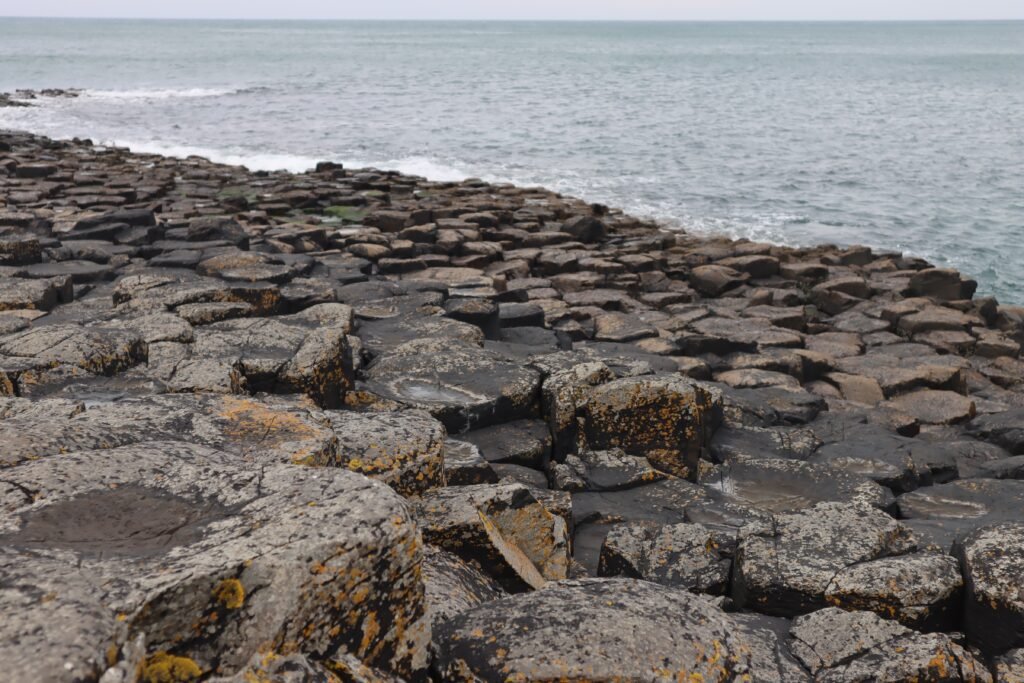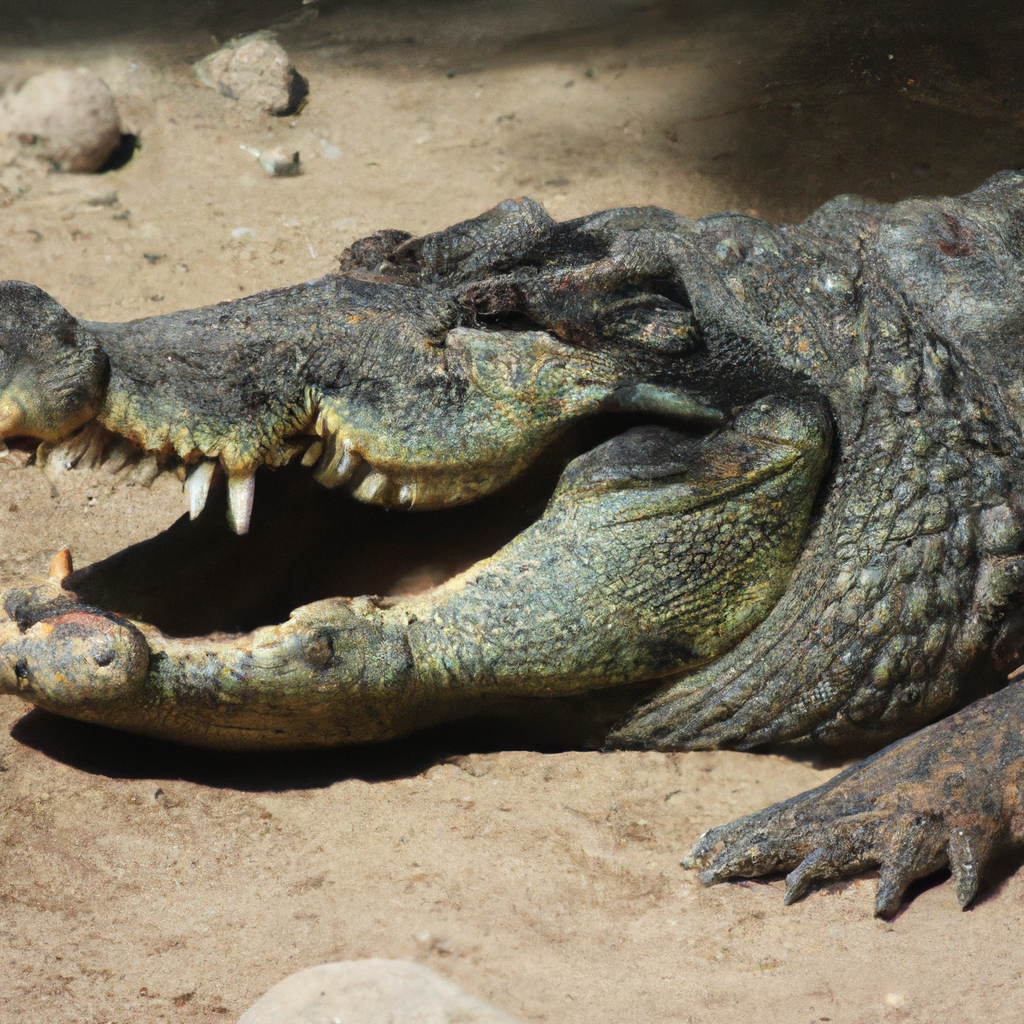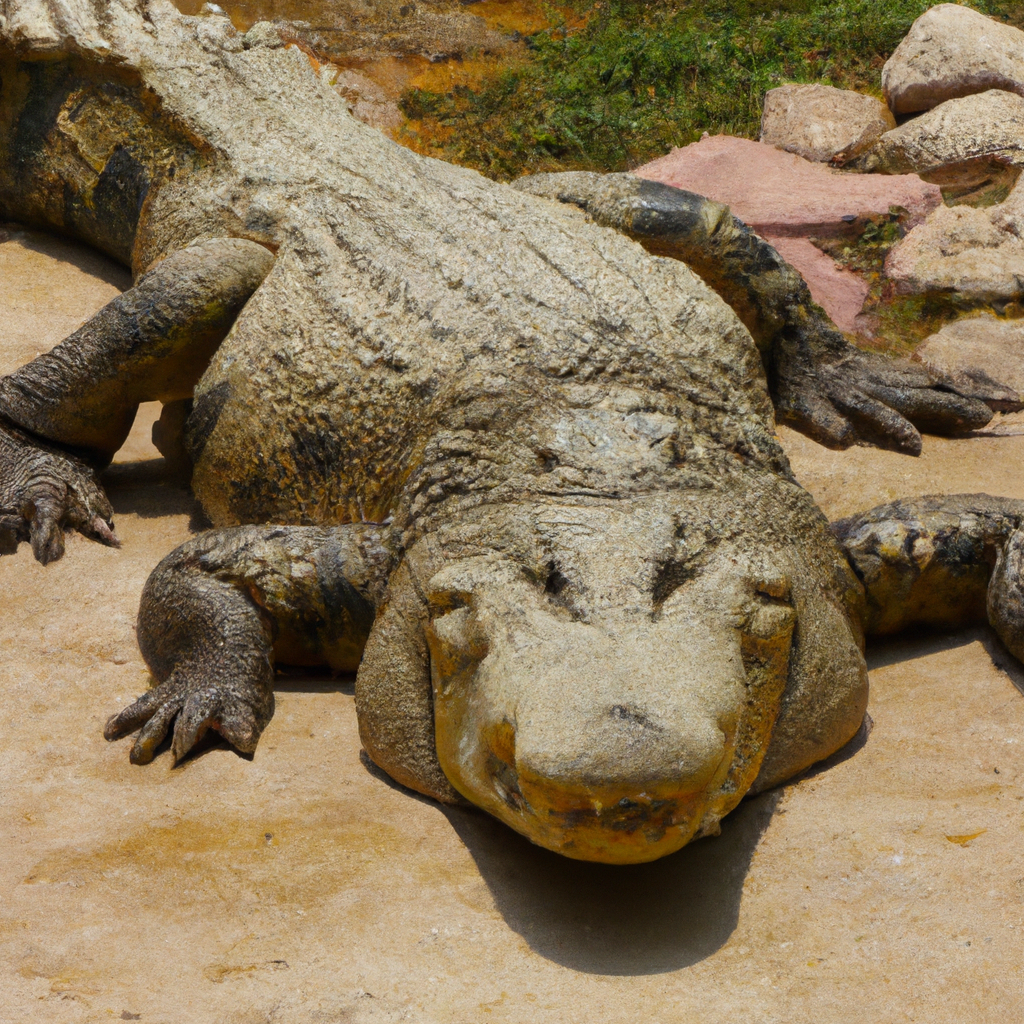Imagine yourself standing on the edge of a river, surrounded by lush greenery and the melodies of nature. As you peer into the deep water, you catch a glimpse of something truly awe-inspiring – gigantic crocodiles. Yes, you read that right – immense, magnificent creatures known as “Cocodrilos Gigantes.” In this article, we will explore the fascinating world of these giant crocodiles, learning about their size, habitats, and the incredible impact they have on their ecosystems. Get ready to unlock the secrets of these extraordinary reptiles and embark on an unforgettable journey into the realm of Cocodrilos Gigantes.
Physical Characteristics of Giant Crocodiles
Size and Length
Giant crocodiles are known for their impressive size and length. They can reach incredible lengths of up to 20 feet or even more. These massive creatures stand out among other crocodile species due to their sheer size, commanding respect and awe. Imagine coming face-to-face with a creature of such immense proportions!
Weight and Mass
In addition to their extraordinary length, giant crocodiles also possess immense weight and mass. These formidable predators can weigh over 2,000 pounds, making them one of the heaviest reptiles in the world. Their sheer bulk is a testament to their strength and power, which allows them to overpower potential prey efficiently.
Skin and Scales
The skin of giant crocodiles is a marvel of evolution. It is covered in tough and scaly armor, known as osteoderms, which provides protection from external threats. These osteoderms give their skin a rough and textured appearance. The scales are composed of keratin, the same material found in human fingernails, making them incredibly strong and durable. Additionally, their skin coloration, ranging from dark shades of brown to gray or even black, helps them blend into their surrounding environment, aiding in camouflaging and ambushing prey.
Habitat and Distribution
Natural Habitat
Giant crocodiles are well-adapted to a variety of aquatic habitats. They can be found in rivers, lakes, swamps, and even coastal areas. These incredible reptiles are especially fond of freshwater ecosystems, as they provide an abundant source of food, ample shelter, and ideal conditions for breeding and nesting. However, they have also been known to venture into brackish and saltwater habitats, showcasing their adaptability to different environments.
Geographical Distribution
Giant crocodiles are not restricted to a specific region. They can be found in several parts of the world, including Africa, Asia, Australia, and the Americas. In Africa, the Nile crocodile reigns as the largest and most well-known species, while the saltwater crocodile takes the title in Asia and Australia. The American crocodile, found in the United States and parts of Central and South America, also possesses formidable size. Their wide distribution highlights their ability to thrive in various ecosystems with different climates and conditions.
Migration Patterns
Giant crocodiles are not renowned for their long-distance migrations. However, they do exhibit seasonal movements within their habitats. They may relocate to seek better feeding grounds or to find suitable nesting areas. These movements are often influenced by changes in water levels, temperature, and availability of prey. It is fascinating to observe how these colossal creatures navigate their environments with precision and adaptability.

Evolutionary History of Giant Crocodiles
Ancestral Lineage
Giant crocodiles have a rich evolutionary history that stretches back millions of years. They belong to the crocodile family, Crocodylidae, which is one of the oldest reptile lineages still in existence today. Scientists believe that the common ancestor of modern-day crocodiles appeared approximately 80 million years ago during the Late Cretaceous period. This ancestor eventually gave rise to the diverse species of crocodiles we see today, including the giant crocodile species.
Ancient Fossil Records
Fossil records play a crucial role in reconstructing the evolutionary history of giant crocodiles. These preserved remnants of the past provide valuable insights into their ancient relatives and their adaptations over time. Fossils of giant crocodiles have been discovered in various parts of the world. Notable fossil sites include the fossil-rich regions of Argentina, Africa, and Australia. These fossils allow scientists to unravel the fascinating story of how giant crocodiles have evolved and adapted to their environments throughout history.
Evolutionary Adaptations
Over millions of years, giant crocodiles have undergone remarkable evolutionary adaptations to thrive in their respective habitats. Their muscular bodies and streamlined shapes allow for efficient movement through water, while their powerful jaws and sharp teeth enable them to capture and consume their prey with ease. Furthermore, their ability to regulate body temperature by basking in the sun or cooling off in water showcases their remarkable physiological adaptations to different climates and environments. These adaptations have contributed to the success and longevity of giant crocodiles throughout the ages.
Diet and Feeding Behaviors
Predatory Behavior
Giant crocodiles are apex predators, sitting comfortably at the top of the food chain in their ecosystems. Their predatory behavior is renowned for its stealth and patience. These impressive reptiles often lie motionless, partially submerged in water or hidden amongst vegetation, waiting for unsuspecting prey to approach. Once within striking distance, they unleash lightning-fast attacks, using their powerful jaws to grab hold of their prey and drag it underwater, drowning it in a death roll maneuver.
Preferred Prey
While giant crocodiles are opportunistic hunters, their diet mainly consists of fish, birds, amphibians, and smaller mammals that venture near bodies of water. However, their size and power allow them to tackle larger prey as well, such as deer, wild boar, and even other large reptiles. For centuries, these creatures have been regarded as efficient and deadly hunters, capable of taking down prey much larger than themselves.
Feeding Habits
Giant crocodiles are not gluttonous creatures. They have the incredible ability to survive for extended periods without food, enabling them to endure times of scarcity. They have a slow metabolic rate, allowing them to make the most out of a single meal. After consuming their prey, they often retreat to a safe and quiet resting place to digest their meal at their own pace. This feeding behavior maximizes their energy efficiency and ensures they can go for several weeks or months before needing to hunt again.

Reproduction and Life Cycle
Mating Rituals
The mating rituals of giant crocodiles are fascinating displays of courtship and dominance. Male crocodiles will engage in loud vocalizations, aggressive posturing, and even physical combat to establish dominance and win the attention of females. Once a male successfully courts a female, they engage in a unique method of reproduction called internal fertilization, where the male transfers sperm to the female through a specialized organ known as a phallus, which is retractable when not in use.
Nesting and Egg Laying
After mating, female giant crocodiles seek out suitable nesting sites to lay their eggs. They construct large mounds made of vegetation and soil near water bodies, providing an ideal environment for their eggs to develop. The female crocodile fiercely guards her nest against potential threats, fending off predators with aggressive displays and powerful jaws. The incubation period can last for several months, depending on environmental conditions, before the eggs hatch.
Parental Care
Giant crocodiles exhibit interesting parental care, exhibiting a level of dedication rarely seen in reptiles. After their eggs hatch, the female assists her offspring by gently carrying them in her mouth to the water, protecting them from potential predators. Once in the water, the female continues to guard and protect her young, ensuring their survival during their early stages of life. This nurturing behavior highlights the strong maternal instincts of giant crocodiles, fostering the survival of the next generation.
Threats and Conservation
Human-Induced Threats
Giant crocodiles face various human-induced threats that have led to population declines in certain regions. Habitat destruction, pollution, and climate change pose significant challenges to the survival of these majestic creatures. Illegal hunting and poaching for their valuable skin and body parts have also had detrimental effects on their populations. As human activities continue to encroach upon their habitats, it is vital to address these threats and promote conservation efforts to prevent the loss of these incredible animals.
Conservation Efforts
Conservation organizations and governments around the world recognize the importance of protecting giant crocodiles and their habitats. Intensive research, monitoring, and population surveys are conducted to gather valuable data on their populations and behaviors. These efforts allow scientists to assess the health of their populations and design effective conservation strategies.
Protection Measures
To safeguard these magnificent reptiles, various protection measures have been put in place. Legislation and regulations have been enacted to control hunting, ban the trade of crocodile products, and establish protected areas where they can thrive undisturbed. Additionally, public education and awareness campaigns aim to promote conservation and a greater appreciation for the ecological roles of giant crocodiles in their ecosystems.

Cultural Significance in Mythology and Folklore
Ancient Legends and Myths
Giant crocodiles hold a significant place in the ancient legends and myths of many cultures around the world. In some ancient Egyptian mythology, the crocodile god Sobek, often depicted as a giant crocodile or a crocodile-headed figure, symbolized power, fertility, and protection. Similarly, in the indigenous mythology of Australia, the saltwater crocodile is revered as a creator figure and is intricately woven into the cultural fabric of Aboriginal peoples.
Symbolism and Superstitions
Crocodiles, including their giant counterparts, often carry symbolic meaning and superstitions in different cultures. In some societies, they symbolize strength, longevity, and survival. They are also regarded as guardians, protecting sacred sites and bodies of water. However, in other cultures, they are viewed with fear and caution, representing danger and unpredictable forces of nature. These deep-rooted beliefs and superstitions reflect the longstanding fascination and respect humanity has held for these mighty creatures.
Cultural Representations
Giant crocodiles have made their way into various forms of cultural representation, including art, literature, and religious rituals. They have been depicted in ancient cave paintings, sculptures, and pottery, showcasing their cultural significance and influence. In literature, they have made appearances in folktales, novels, and even children’s books, captivating audiences with their powerful presence and intriguing behaviors. Additionally, they play a role in traditional ceremonies and rituals in certain cultures, serving as a connection between the physical and spiritual realms.
Giant Crocodiles in Popular Culture
Movies and Television
Giant crocodiles have made their mark in popular culture through movies and television. Numerous films, both fictional and inspired by true events, depict the ferocity and danger associated with these colossal reptiles. From the classic “Jaws” franchise to more recent films like “Lake Placid” and “Rogue,” giant crocodiles have become iconic creatures, a source of both entertainment and thrilling suspense for audiences worldwide. They have left an indelible mark in the realms of cinema and television.
Literary References
Authors throughout history have drawn inspiration from giant crocodiles, incorporating them into their literature. From classic novels like Rudyard Kipling’s “The Jungle Book,” where the iconic character of Kaa the python fights against a crocodile, to contemporary works that explore the myth and mystery surrounding giant crocodiles, these creatures continue to captivate the imagination of readers. Their presence in literature adds depth and intrigue to stories, showcasing the enduring fascination humans have with these magnificent reptiles.
Tourist Attractions
In regions where giant crocodiles are abundant, tourist attractions have emerged, providing visitors with a chance to see these incredible creatures up close. Carefully managed eco-tourism initiatives offer guided safaris, river cruises, and educational programs, allowing individuals to witness the magnificence of giant crocodiles in their natural habitats. These attractions provide not only thrilling experiences for tourists but also contribute to the local economy and raise awareness about the importance of conservation.

Misconceptions and Myths about Giant Crocodiles
Exaggerated Tales
Giant crocodiles have been the subject of exaggerated tales and stories throughout history. Numerous accounts have surfaced, claiming to document record-breaking sizes and mythical proportions. While it is true that giant crocodiles are the largest of their kind, it is essential to separate fact from fiction. Many claims of immense size are often based on hearsay or unreliable measurements, perpetuating misconceptions about the true size and capabilities of these creatures.
Urban Legends
Urban legends surrounding giant crocodiles have thrived in certain regions, fueled by people’s fascination with these creatures. Tales of crocodiles lurking in urban sewers or preying on unsuspecting swimmers in remote lakes continue to capture the imagination. However, these urban legends are largely unfounded and lack credible evidence. It is crucial to approach such stories with skepticism and rely on scientific research to gain a true understanding of these remarkable reptiles.
Myth Debunking
To dispel myths and misconceptions about giant crocodiles, scientific research and education play a vital role. Studies conducted by experts in the field help provide accurate data regarding their size, behavior, and ecological significance. By debunking exaggerated tales and urban legends, a clearer picture can emerge, allowing individuals to appreciate the true nature of these awe-inspiring creatures.
Research and Conservation Challenges
Studying Elusive Species
Studying giant crocodiles poses numerous challenges due to their elusive nature. Their habitats are often remote and inaccessible, making it challenging for researchers to observe them directly. The need for specialized equipment, such as tracking devices and underwater cameras, adds to the complexity of studying these massive reptiles. However, advancements in technology, including satellite tracking and aerial surveys, have provided valuable insights into their behavior and movement patterns, aiding ongoing research efforts.
Tracking and Monitoring
Tracking and monitoring the population dynamics of giant crocodiles require innovative techniques and a collaborative approach. Non-invasive methods, such as using satellite tags and radio telemetry, allow researchers to follow individual crocodiles’ movements and understand their habitat preferences. By collecting data on their population size, reproductive rates, and health, researchers can develop effective conservation strategies to protect these magnificent creatures.
Population Surveys
Assessing the population status of giant crocodiles can be a daunting task due to their secretive nature. Population surveys utilizing various sampling methods, such as aerial surveys, camera trapping, and capture-mark-recapture techniques, provide estimates of population size and help identify potential threats. These surveys are crucial for evaluating the success of conservation efforts and implementing appropriate management plans to ensure the long-term survival of these remarkable reptiles.
In conclusion, giant crocodiles are extraordinary creatures that command attention and capture the imagination. Their physical characteristics, habitats, evolutionary history, and behaviors make them a subject of awe and fascination for people worldwide. However, it is essential to separate fact from fiction, dispel myths and misconceptions, and focus on research and conservation efforts to protect these majestic reptiles. Through effective conservation measures, education, and respect for their habitats, we can ensure that giant crocodiles continue to thrive for generations to come.

